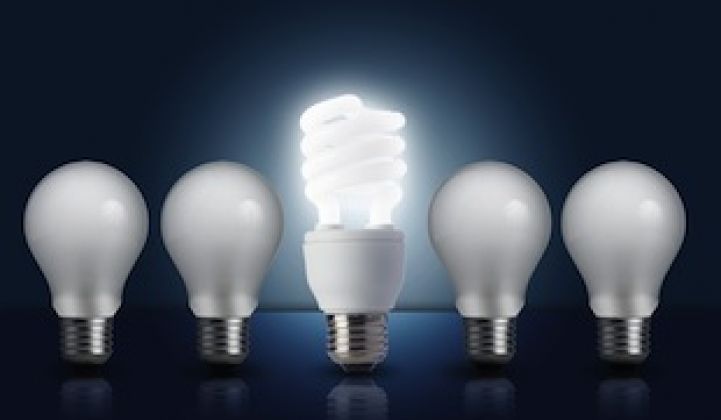The American Council for an Energy-Efficient Economy has just completed its third national review of exemplary efficiency programs. With over 60 programs being recognized, one thing is clear: energy efficiency programs have taken off with remarkable speed over the last few years.
Let's take a look at five of the most innovative programs covered in the report, spanning the biggest efficiency sectors.
Best of Residential Lighting: The Residential Upstream Lighting Program
Pacific Gas and Electric Company has $10 million earmarked in its Residential Upstream Lighting Program. The program has two prongs: PG&E works with manufacturers to bring down costs before products are sold to retailers and then provides incentives at the retail level to help the competitiveness of those products against traditional lighting.
The annual energy savings from the program in 2012 were 245 gigawatt-hours, with a peak savings of 36.5 megawatts over the summer. That came from distributing 5.4 million CFL and LED lamps and fixtures. This led to 61,500 megatons of reduced CO2 emissions, which is equivalent to taking 12,800 cars off the road.
Topping the Industrial Category: The Focus on Energy Program
Wisconsin's Focus on Energy program targeted big industrial consumers such as “pulp and paper mills, food processors, printers, ethanol producers, and wastewater facilities.” On the technology side, the program covers everything under the sun, from lighting to HVAC and steam systems to biogas conversion. The report notes a few interesting special offers the program has put in place, including competitive RFP’s with increased caps, staffing grants, and bundled ARRA grants.
Over the last twelve years, the program has reached 4,000 customers, with 16,000 projects since 2009. In 2011 it was budgeted for $17 million, saved 154 million kilowatt-hours with a peak summer demand savings of 21 megawatts, and leveraged $15 million in grants from the Department of Energy.
Champions of Multifamily: The Energy Savers Program
CNT Energy and Community Investment Corporation started in 2008 as part of an initiative designed to preserve affordable housing in Cook County and has continued to expand ever since. The Energy Saver team starts with an energy assessment of the home, including analyzing utility bills and assessing installed technologies. Next, they offer financial guidance to secure a 3 percent fixed-rate, seven-year loan through the Community Investment Corporation. This is invested in the retrofits, and grants and rebates are also procured and applied. The team then oversees the construction process, and draws on an existing pool of screened contractors.
A large part of the program’s success is the monitoring and follow-up that the team performs afterwards. There is training of the buildings staff, tune-ups if technology isn’t performing up to par, and annual reports. Program spending peaked in 2011 at $8.5 million, and then decreased to $5.2 million in 2012, with 2 million therms of gas and $5.6 million kilowatt-hours saved since 2010. Participation in the program has climbed year on year, from 132 buildings in 2010 to 195 buildings in 2012.
One particularly interesting lesson learned from Energy Savers is that “complex technical reports are not essential,” as reports have shrunk from fifteen pages at the outset to the current average length of four to five pages. As ACEEE notes, this means “less discussion of U-factors and coefficients of performance and a much greater focus on dollars and cents.”
Loans for Homes: On-Bill Recovery Financing
The New York State Energy Research and Development Authority (NYSERDA) developed the On-Bill Recovery Financing program in 2012 to offer loans for energy-efficient upgrades that are paid back through utility billing programs. As long as customers qualify by having an acceptable credit score, an appropriate debt-to-income ratio, and no bankruptcies, they qualify for the loans, which are capped at $25,000 with 2.99 percent interest for residential and $50,000 with 2.75 percent interest for small businesses and nonprofits.
The first full year saw 1,253 loans granted. More than 500 loans were fully issued, for a total of $5.6 million. Another 276 loans worth $3 million were approved pending completion and 440 loans worth $4 million were preapproved. There is even a tier of loans with special underwriting for consumers who may not qualify for traditional financing, amounting to 9 percent of all loans. So far, over the last year, 434,000 kilowatt-hours have been saved.
Transforming Markets: The LED Accelerator
Energy Solutions and Pacific Gas and Electric Company teamed up to form the LED Accelerator program, which is designed to “incentivize the newest and most energy-efficient LED technologies available.” The program tries to go beyond the status quo to deploy the best equipment and create markets. To accomplish this, there are several tiers of energy reductions accompanied by increasing incentives offered for peak reductions. For instance, Tier 1 offered $600 per peak kilowatt reduced, Tier 2 is $1,000 per kilowatt reduced, and so on.
Since the program targets large customers, often with businesses or stores spread across the country, adoption of new technologies and the education about efficiency can have a huge impact. Between 2010 and 2012, $2.4 million was spent, with 2,000 kilowatts and 8.4 million kilowatt-hours saved.
The ACEEE report makes an important note about this kind of program, stating that since it is so new, "goals should be based on participation instead of hard-set savings goals, as market transformation takes time and strategies may need revision.” The program is budgeted for $1.8 million for the 2013-2014 cycle.
***
Adam James is a Research Assistant for Energy Policy at the Center for American Progress and the Executive Director of the Clean Energy Leadership Institute. You can email him at [email protected] and follow him on Twitter @adam_s_james.



